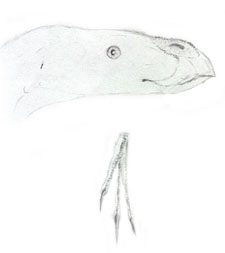
Chirostenotes (pergracilis?)

Northern North America (Alberta and Montana) is a habitat quite different from arid Mongolia. In the rain shadow of the new Rocky Mountains and near the coast of the Kansas sea, it is a wet and warm forested environment. Chirostenotes pergracilis has abandoned the box-shaped skull of Caenagnathasia , having a long, tapering snout that somewhat resembles Microventor 's (to which C. pergracilis is distantly related). While it is too lightly built to crush any hard food, such as crustaceans, the loosely-built skull of allows the animal to swallow a wide variety of food. The crest that decorates its head is high and round, rather similar to derived oviraptorosaurs like Rinchenia . However, C. pergracilis is very much a caegnathid in all other respects of its anatomy, and so it seems that the decorative crest has arisen several times among the oviraptorosaurs.
In its habits, C. pergracilis is like a terrestrial seagull, eating aquatic detritus and digging tidbits out of sand and rock with its long, thin claws. Further inland, it hunts small animals like lizards and scoops fish out of streams with these same talons. The genus Chirostenotes is fairly successful and has diversified into several species (three known). The other two (C. sternbergi and an unnamed species) have boxier, more powerfully built sculls than C. pergracilis and live on a more restricted diet than it.
(a note on nomenclature) The name Chirostenotes pergracilis was first ascribed to a creature with a crestless, lowslung skull (see picture below). A new specimen, ROM 42350, seems to belong to the same genus, if not the same species, but bears the rounded Rinchenia-like crest of the painting above. Both specimens may belong to the same species, the crest having broken off the previously-discovered skull, but as of now, the true affinities of ROM 42350 are unknown.
Thanks to Ray Stanford, of course.
Other sites containing pertinent information:
® Daniel Bensen 2000
Back to OPUS: Dinosaur
This species is included in a larger painting .